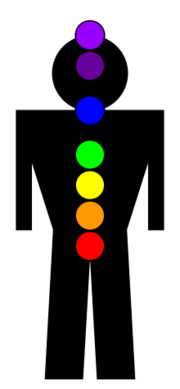Chromotherapy
Other names : color light therapy, Spectro-Chrome therapy, Colorpuncture, color light acupuncture.
See also :
Practitioners of ayurvedic medicine believe the body has seven "chakras," which some claim are 'spiritual centers', and which are held to be located along the spine. In New Age thought each of the chakras is associated with a single color of the visible light spectrum, along with a function and organ or bodily system. According to this view, the chakras can become imbalanced and result in physical diseases but it is believed that these imbalances can be corrected through application of the appropriate color. The purported colors and their associations are described as:
| Color | Chakra | Chakra location | Alleged function | Associated system |
|---|---|---|---|---|
| Red | First | Base of the spine | Grounding and Survival | Gonads, kidneys, spine, sense of smell |
| Orange | Second | Lower abdomen, genitals | Emotions, sexuality | Urinary tract, circulation, reproduction |
| Yellow | Third | Solar plexus | Power, ego | Stomach, liver, gall bladder, pancreas |
| Green | Fourth | Heart | Love, sense of responsibility | Heart, lungs, thymus |
| Blue | Fifth | Throat | Physical and spiritual communication | Throat, ears, mouth, hands |
| Indigo | Sixth | Just above the center of the brow, middle of forehead | Forgiveness, compassion, understanding | Eye, pineal glands |
| Violet | Seventh | Crown of the head | Connection with universal energies, transmission of ideas and information | Pituitary gland, the central nervous system and the cerebral cortex |
American physician Edwin D. Babbitt first introduced color light therapy to the mainstream in 1878, when he published his book, "The Principles of Light and Color." Dr. Seth Pancoast reported similar findings in his book "Light and Its Rays," published in 1877. Influenced by the two doctors' findings, Indian physician, scientist and engineer, Dinshah P. Ghadiali, used color light therapy to treat a woman who was dying of mucous colitis. While other doctors diagnosed her condition as untreatable and left her for dead, Dinshah experimented with what he would later name Spectro-Chrome Color Therapy. Using illumination from a kerosene lantern and a blue-colored glass bottle, Dinshah applied light to the affected areas of her body. She went from suffering from extreme diarrhea 100 times a day, to eliminating only 10 times a day, to shortly thereafter walking about and making a full recovery! Motivated by his success, Dinshah spent the next 23 years optimizing his Spectro-Chrome Color Therapy.
Special Precautions of Chromotherapy
The benefits of Chromotherapy are
- Depression.
- Anxiety.
- Stress.
- Fatigue.
- Pain.
- Cramps.
- Headache.
- Migraine headache.
- Diabetes.
- High blood pressure.
- Asthma.
- Cough.
